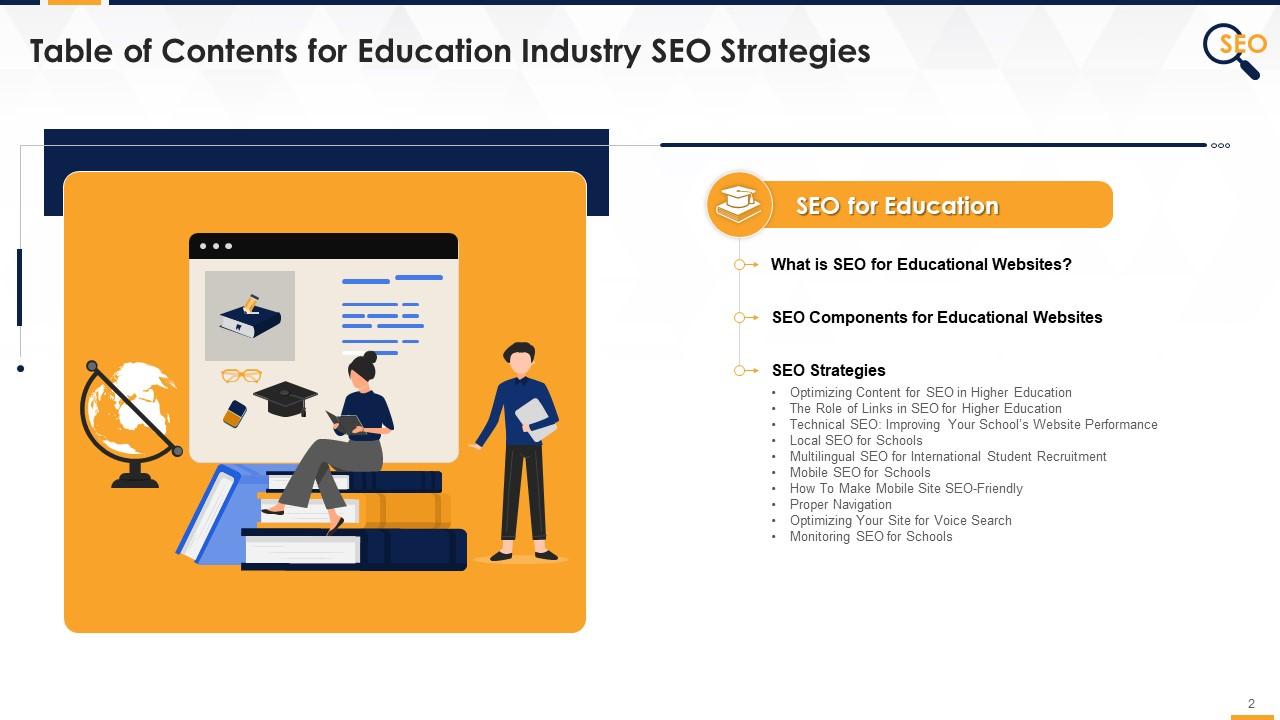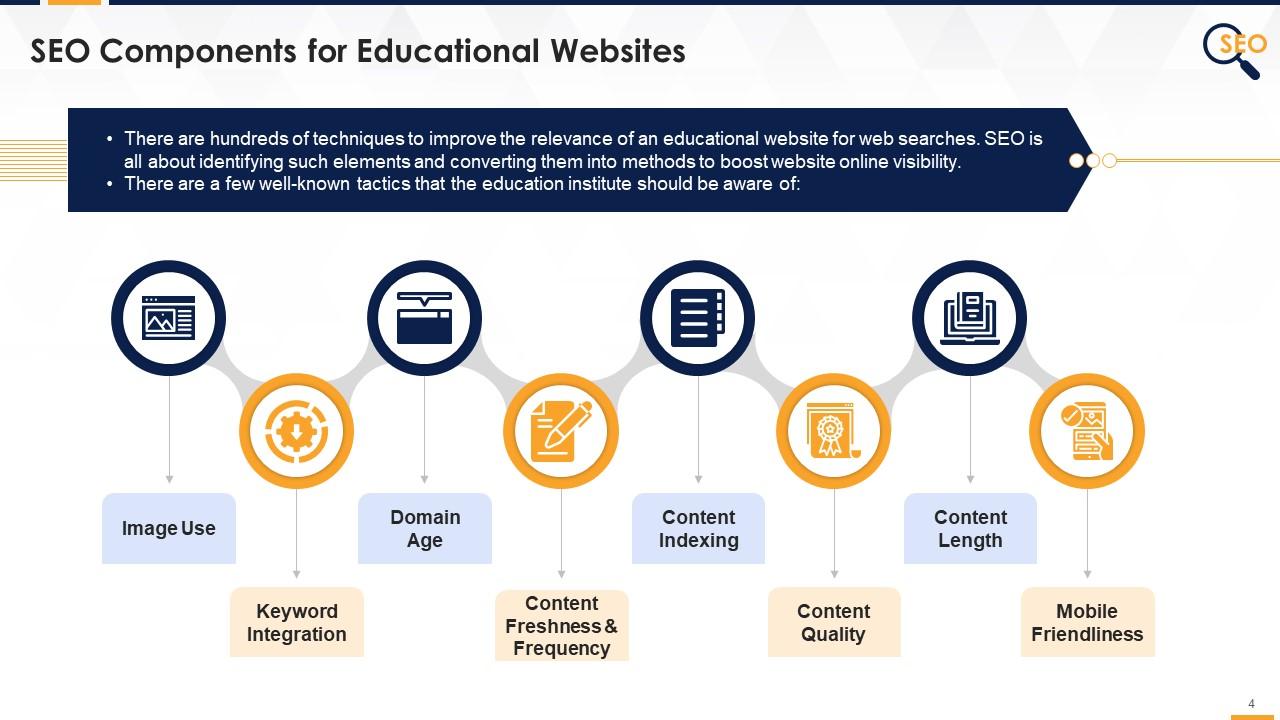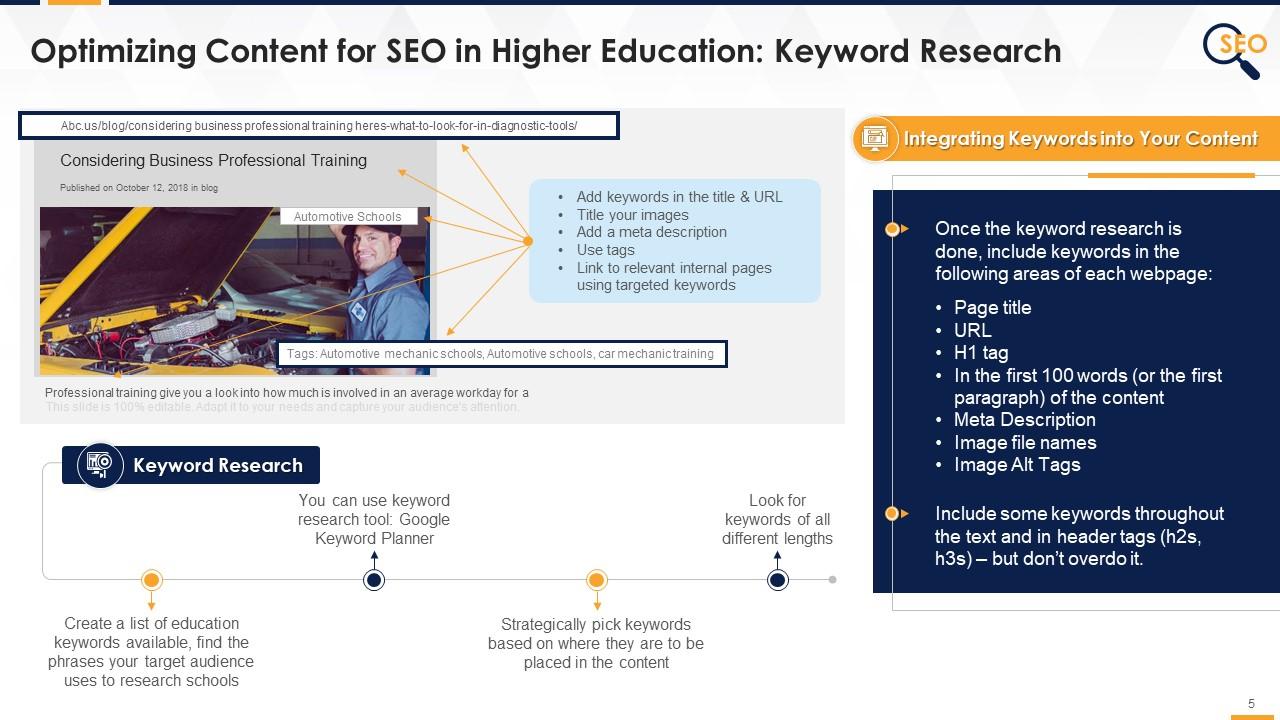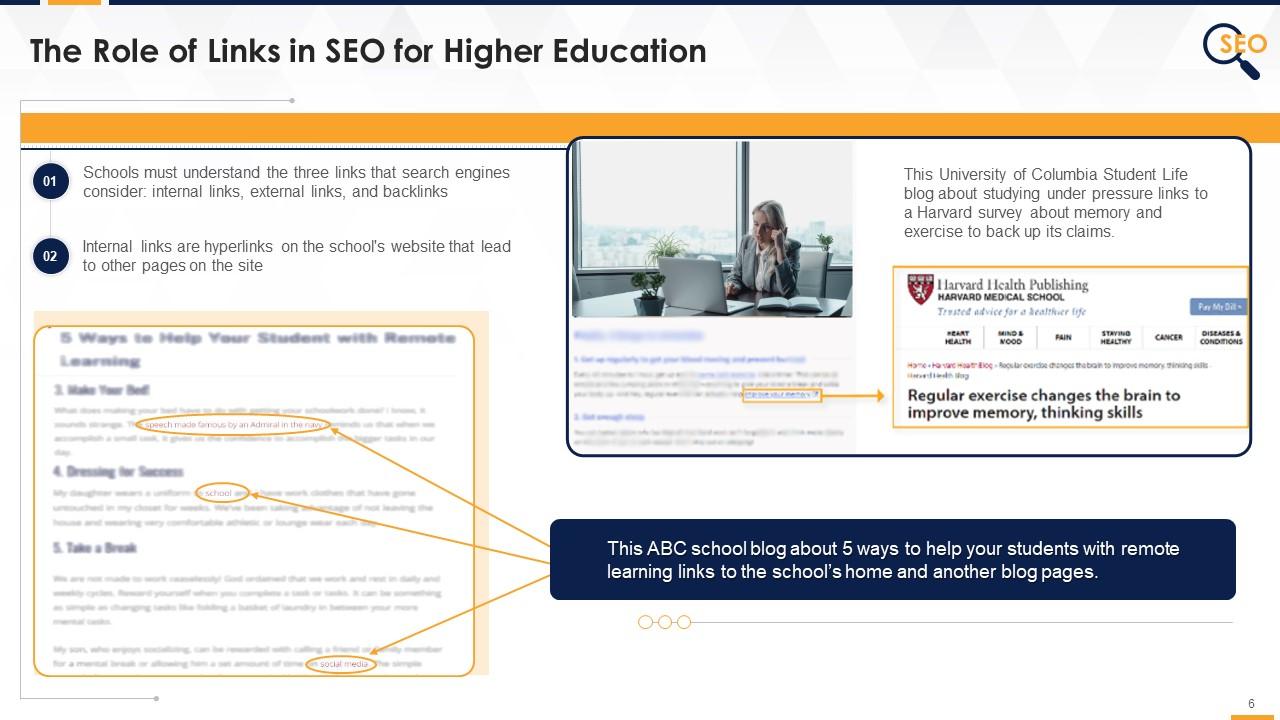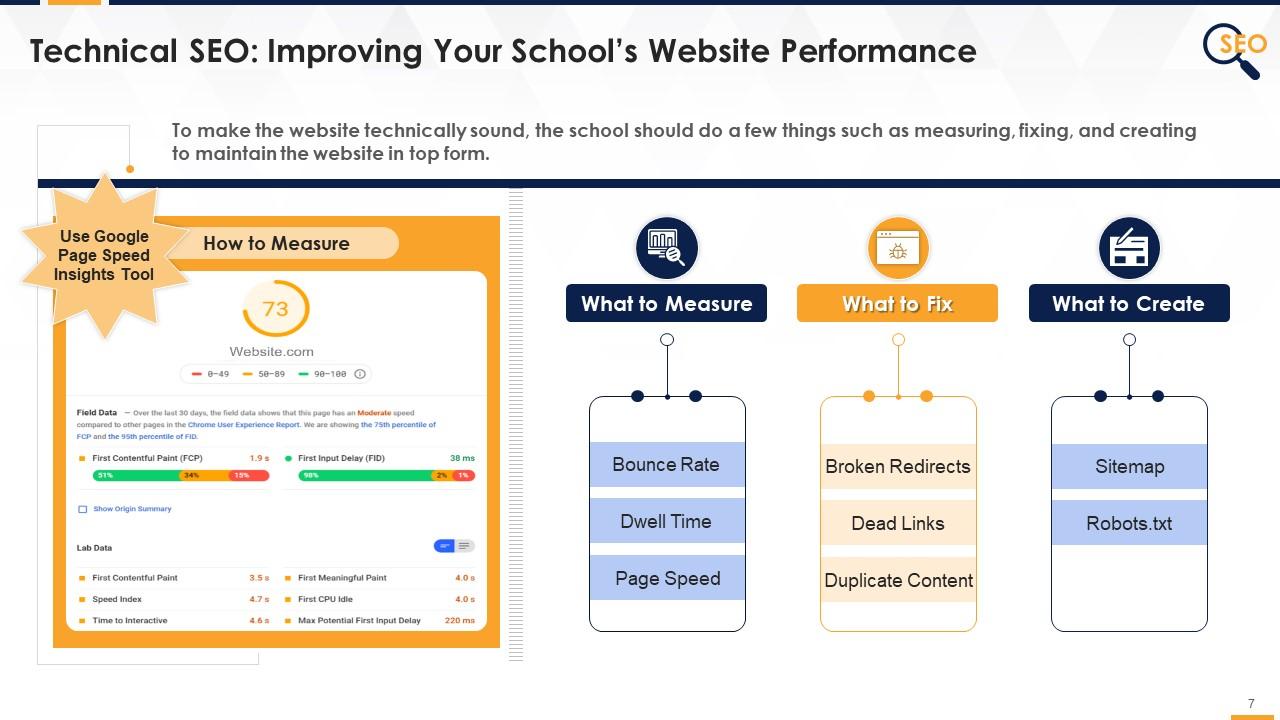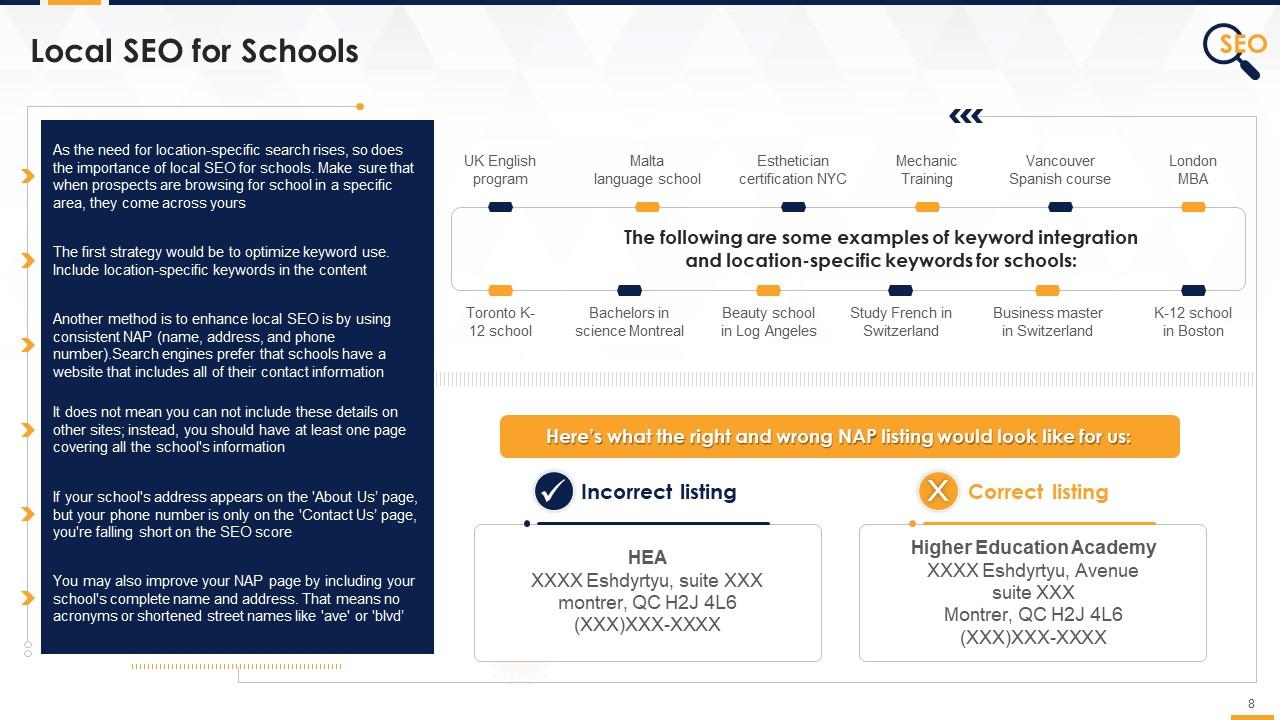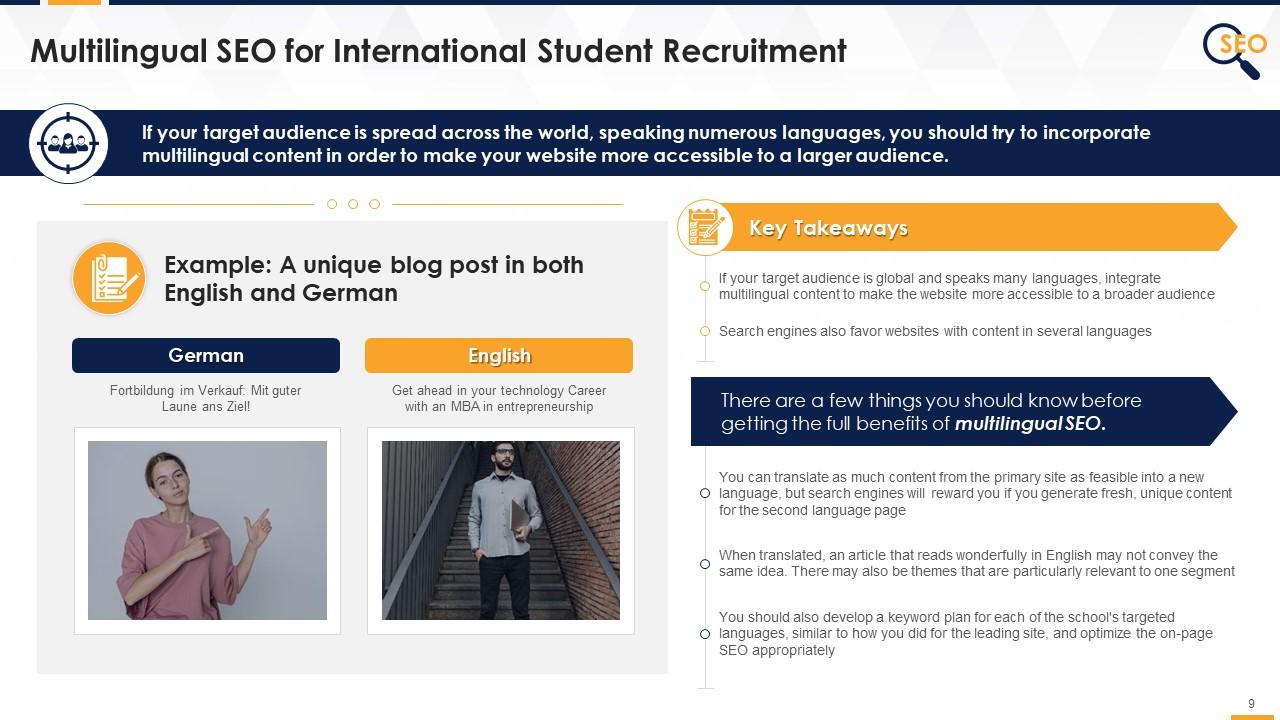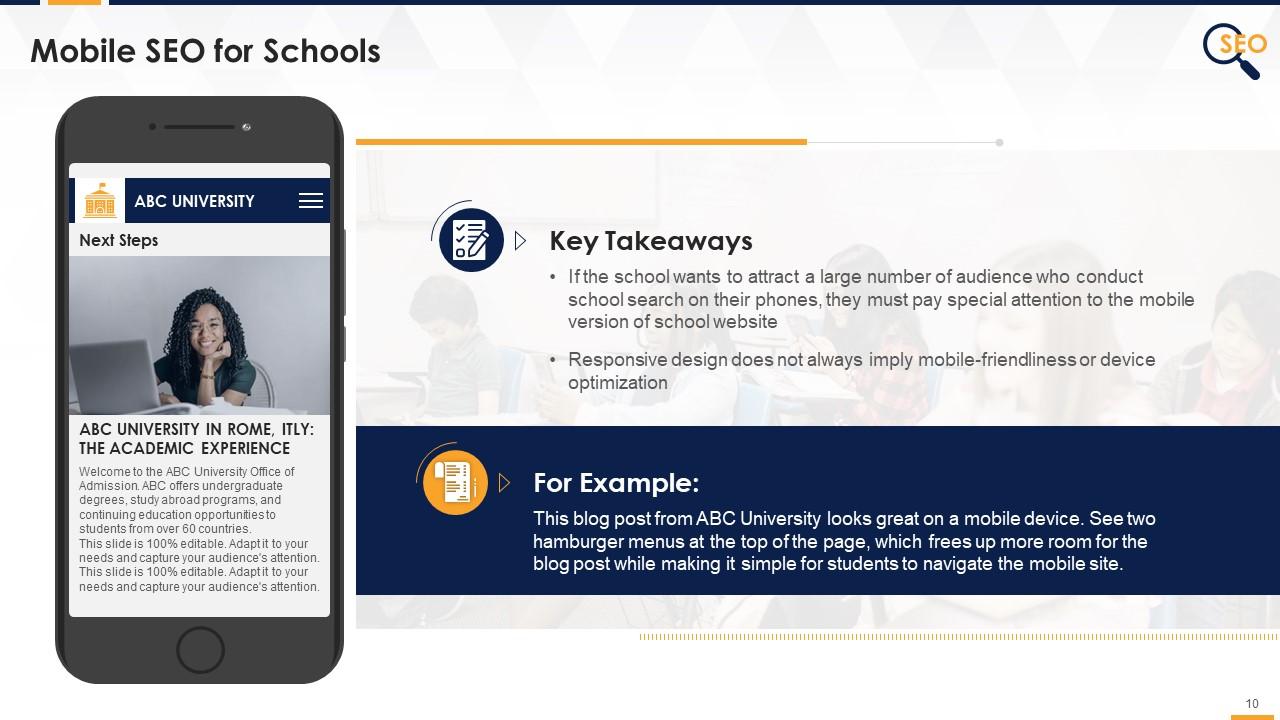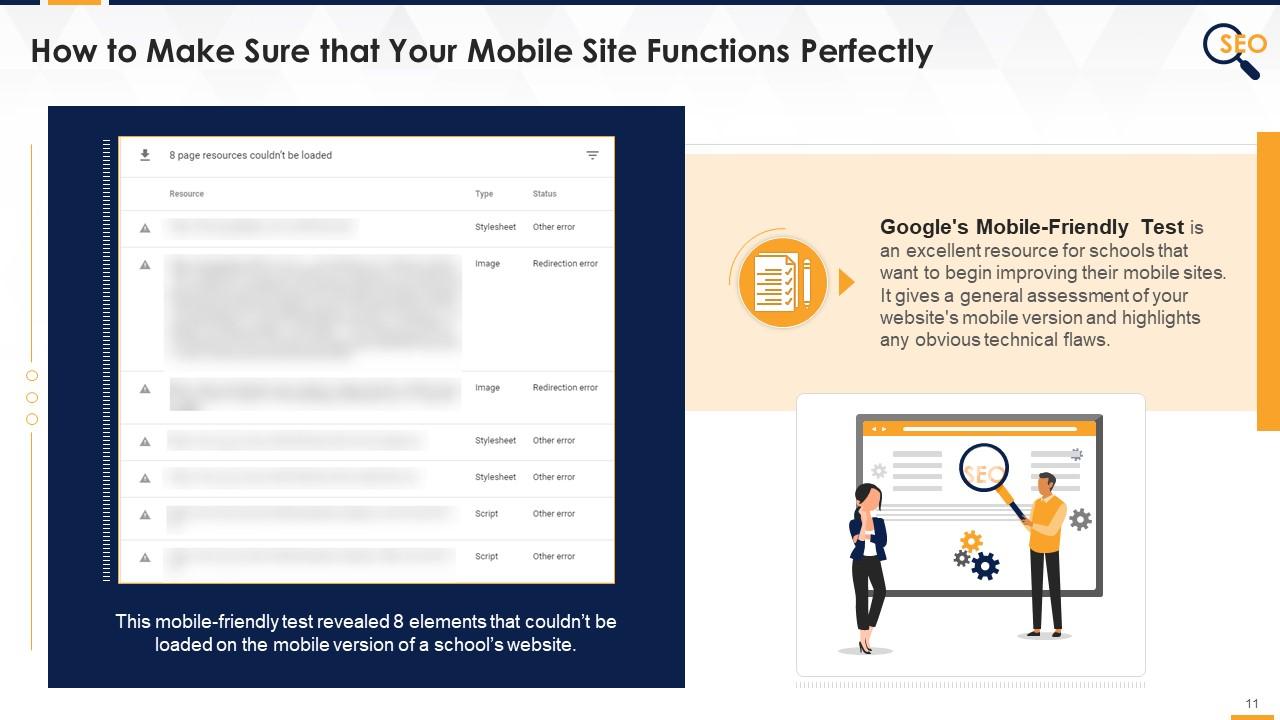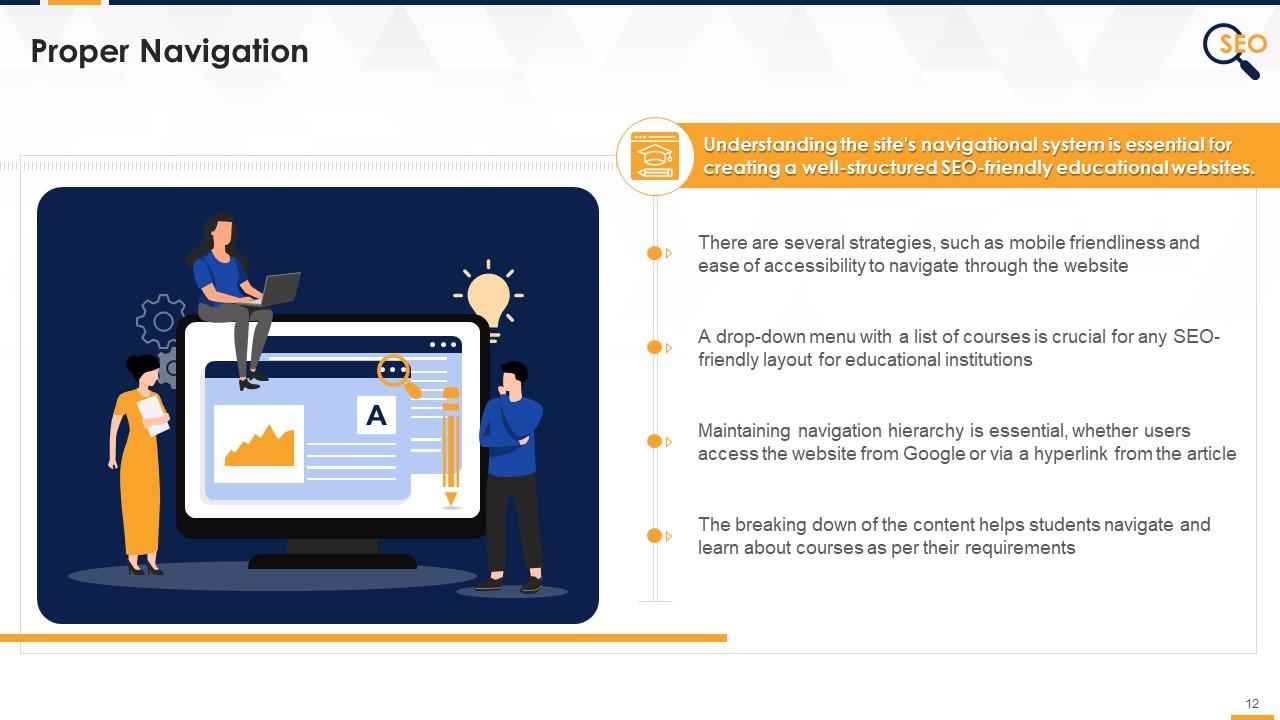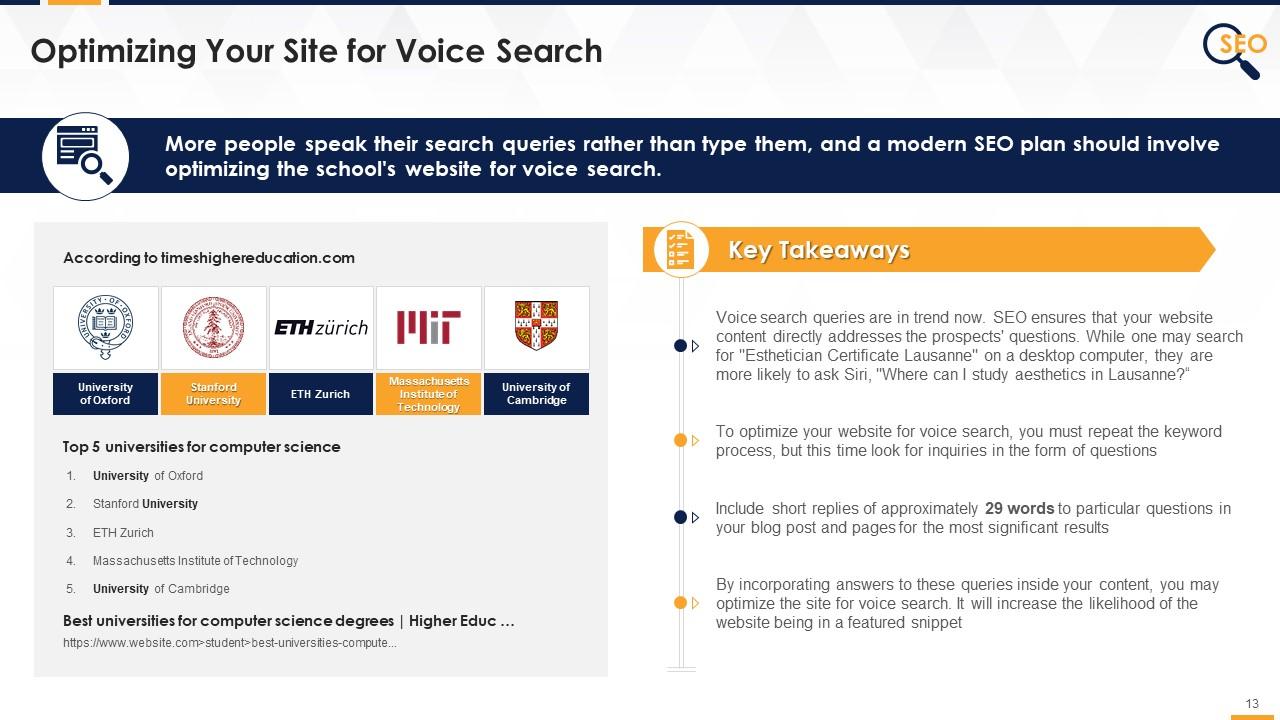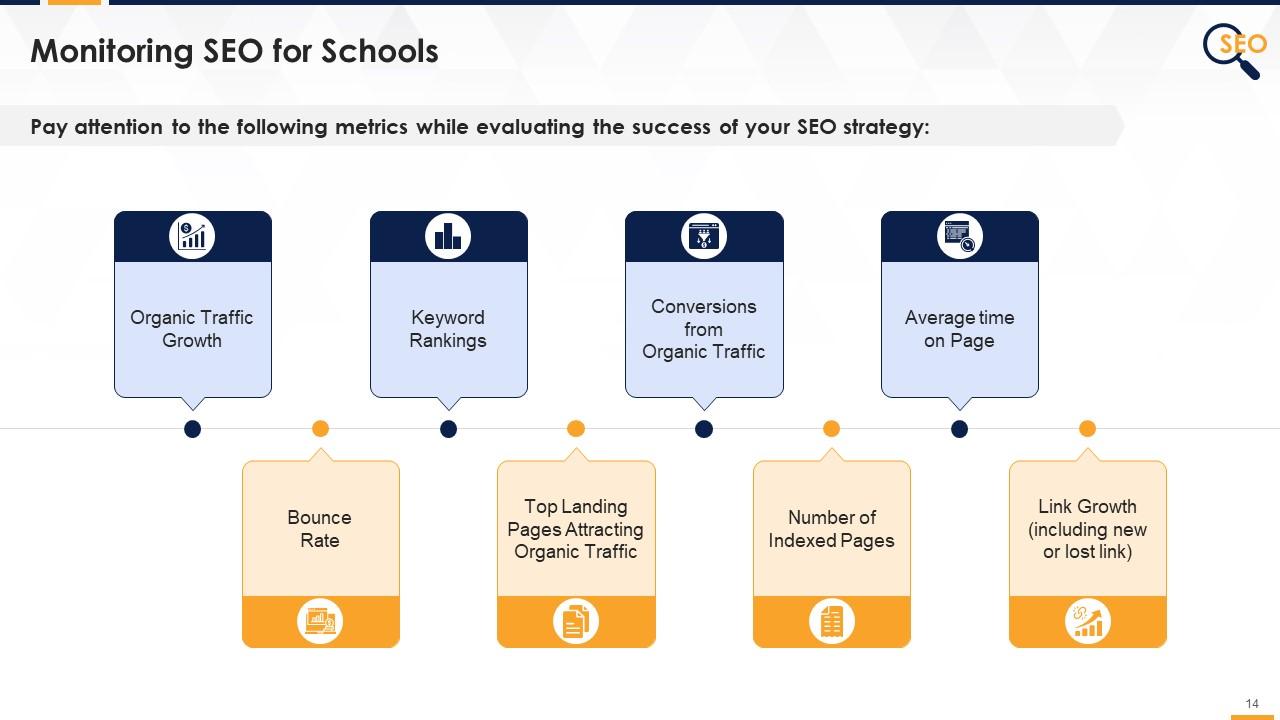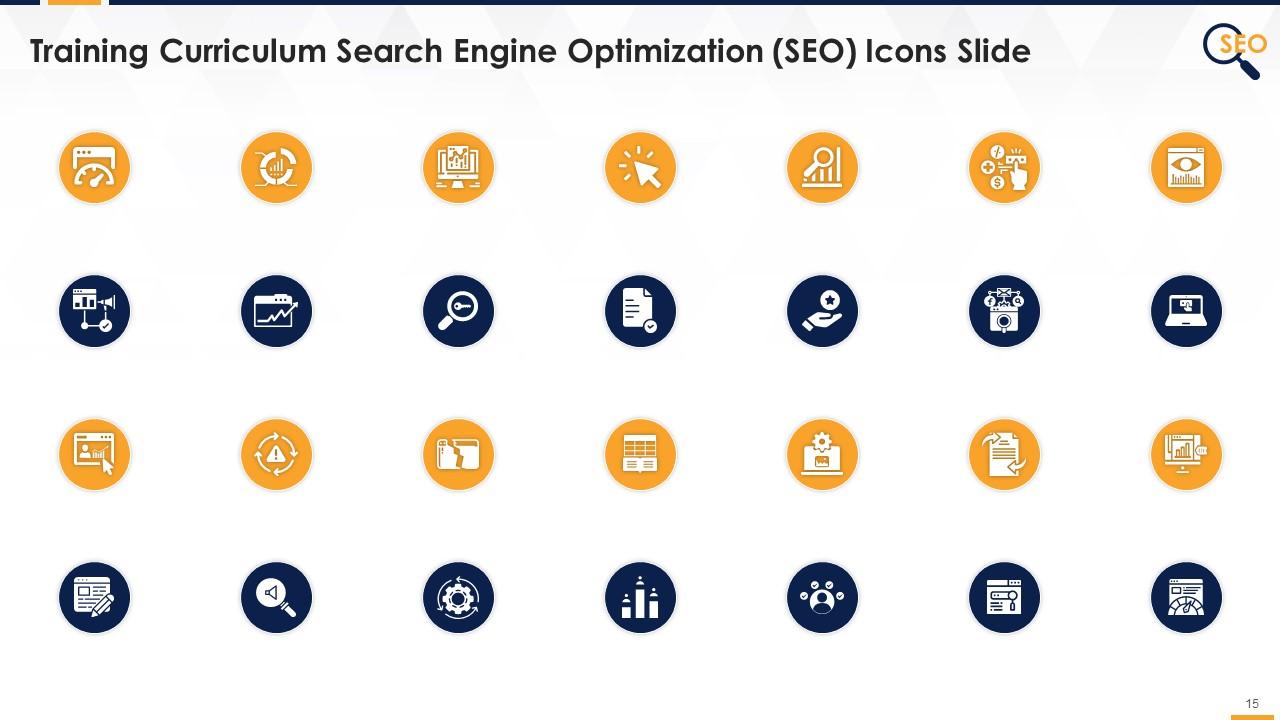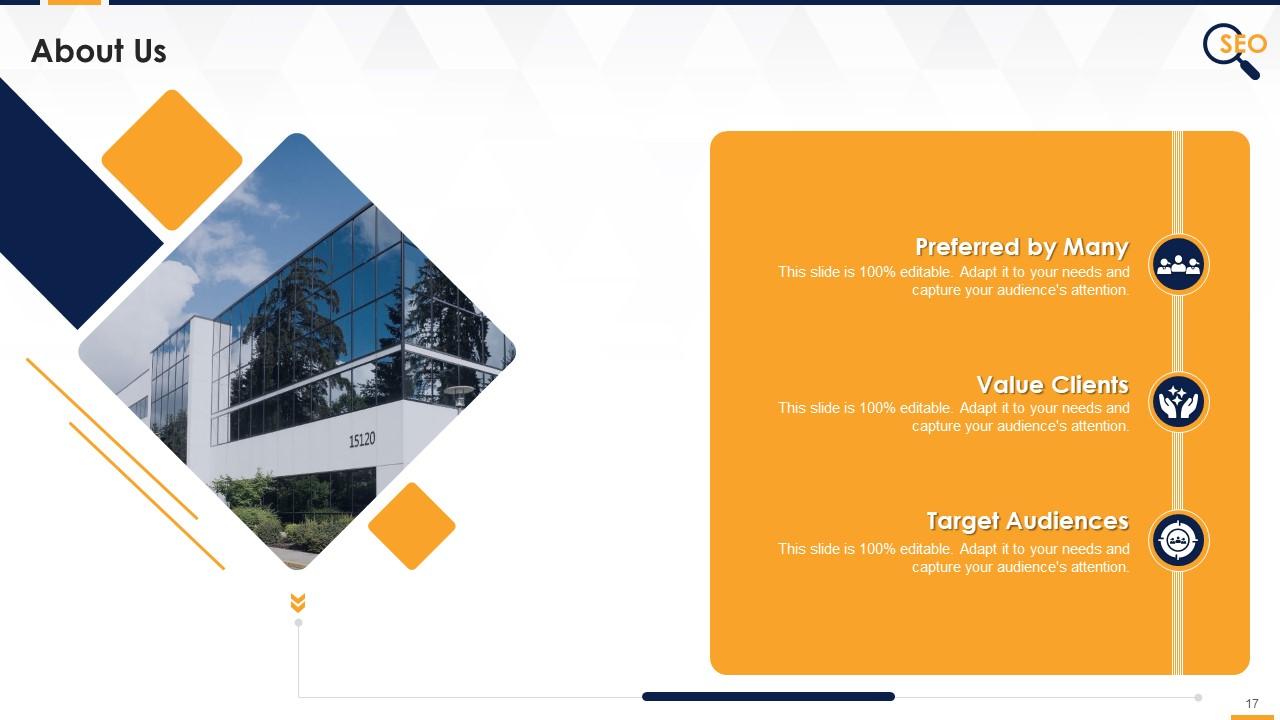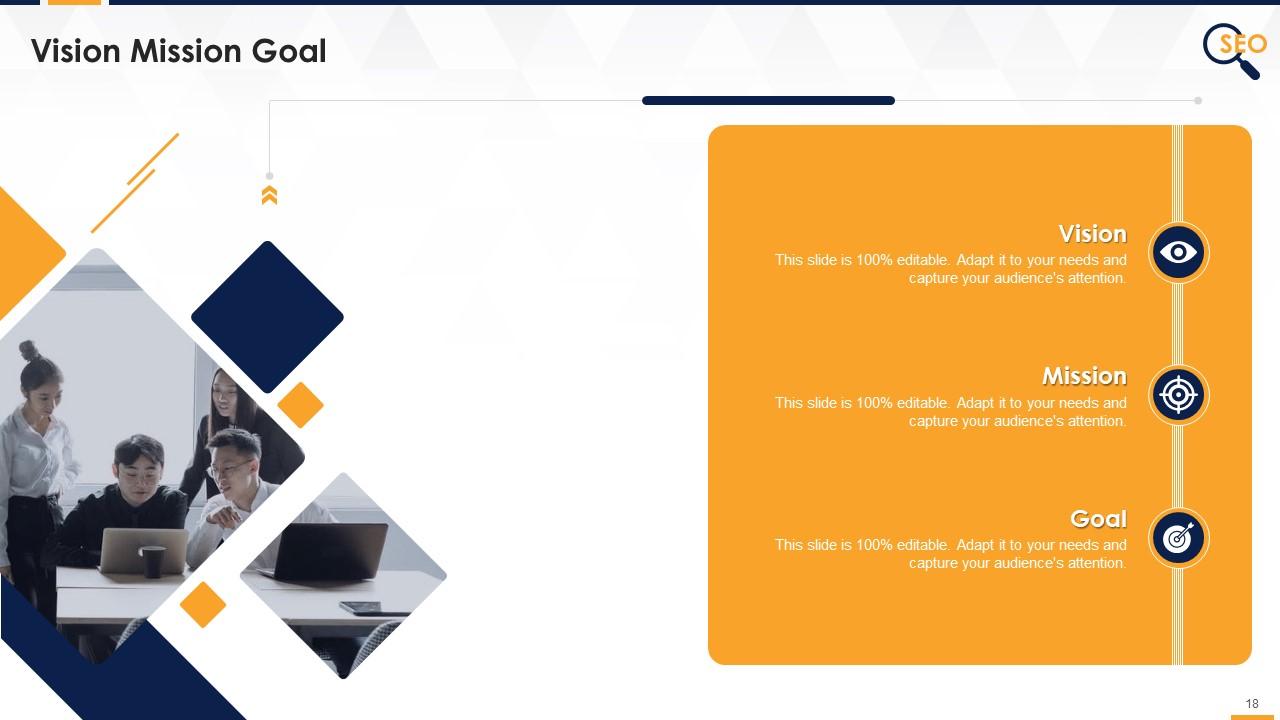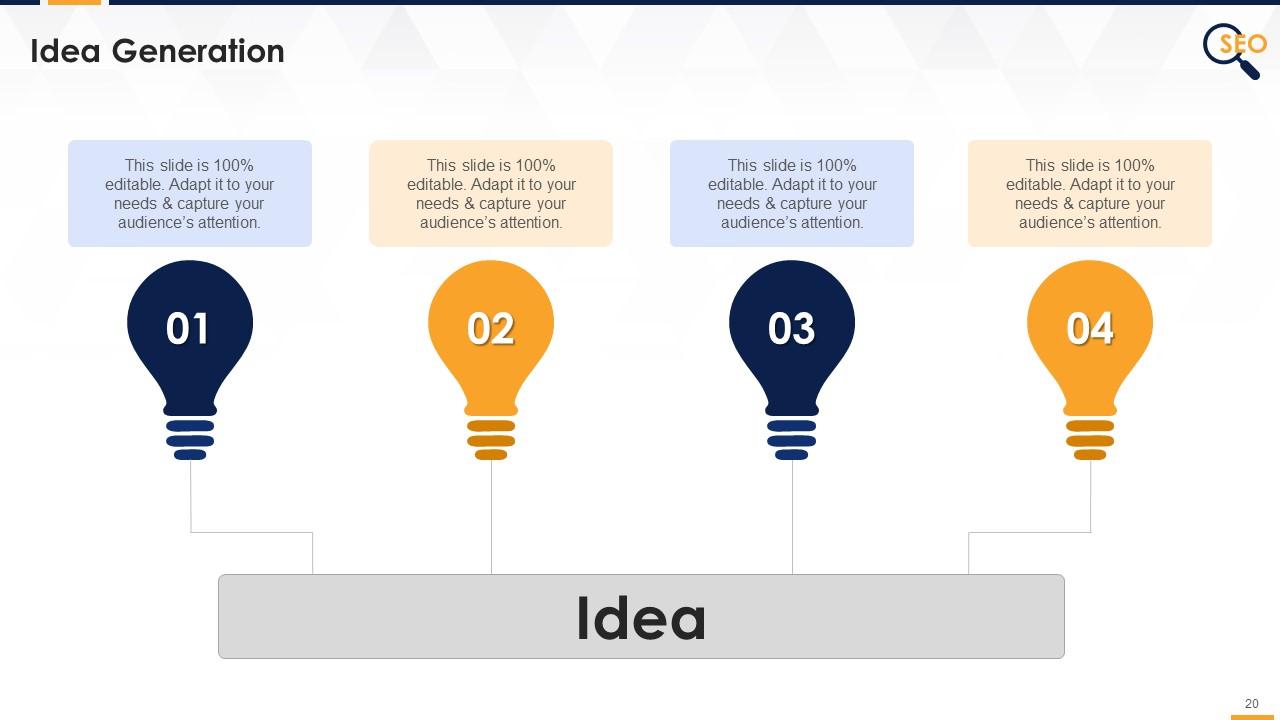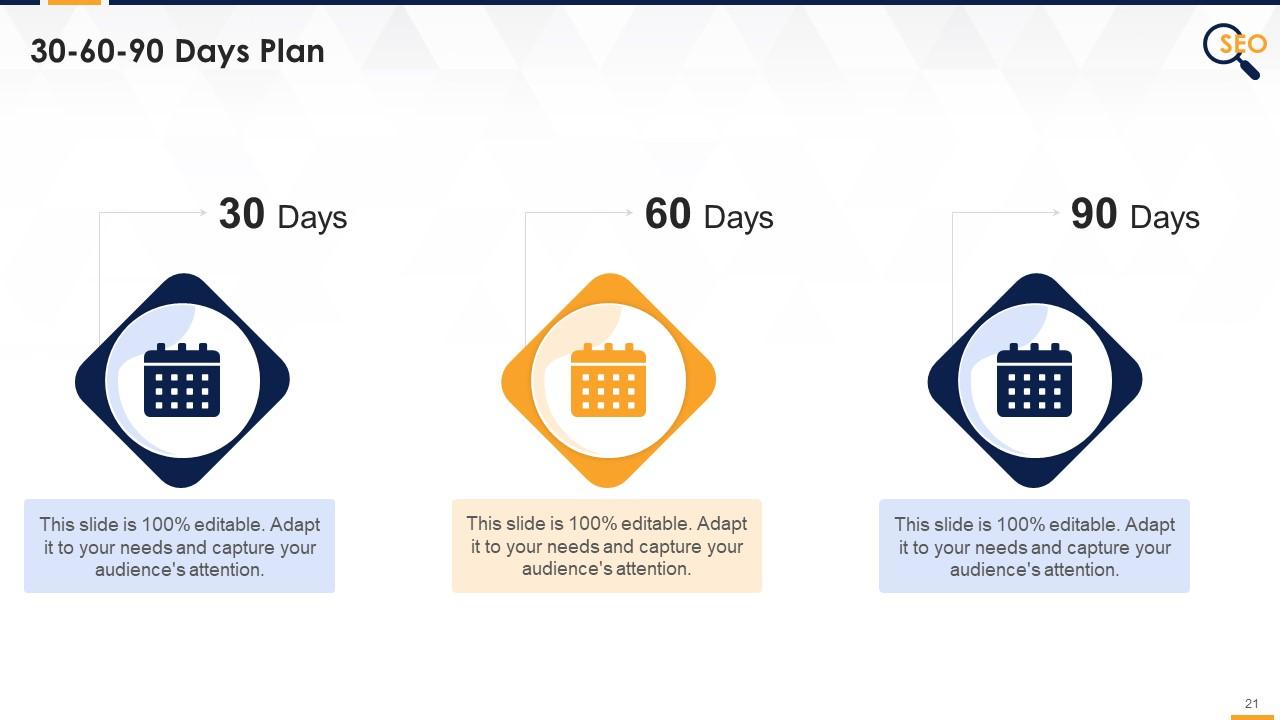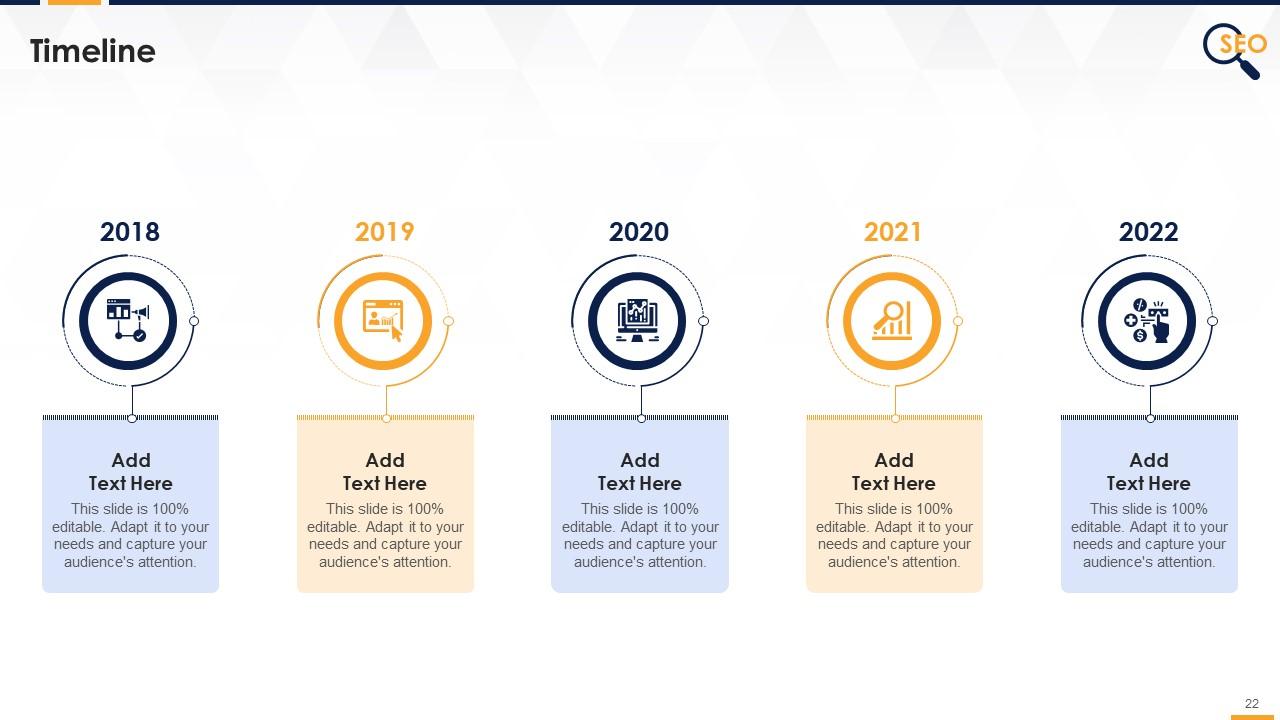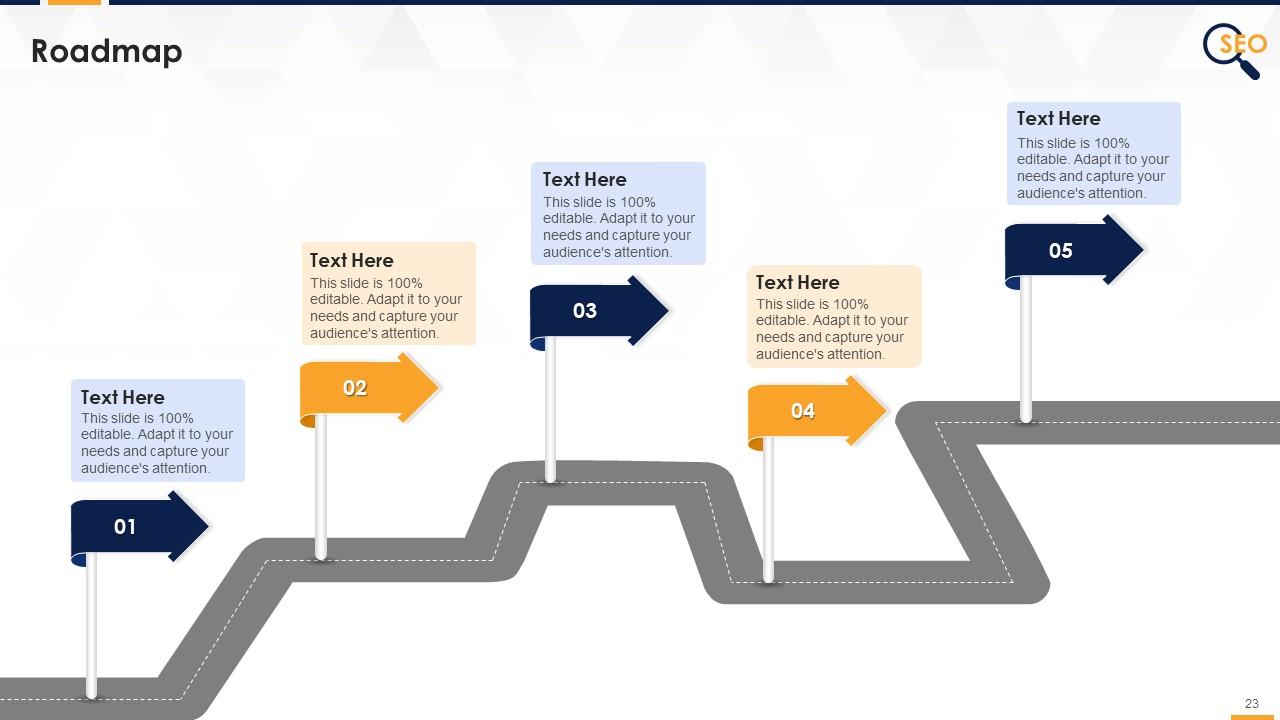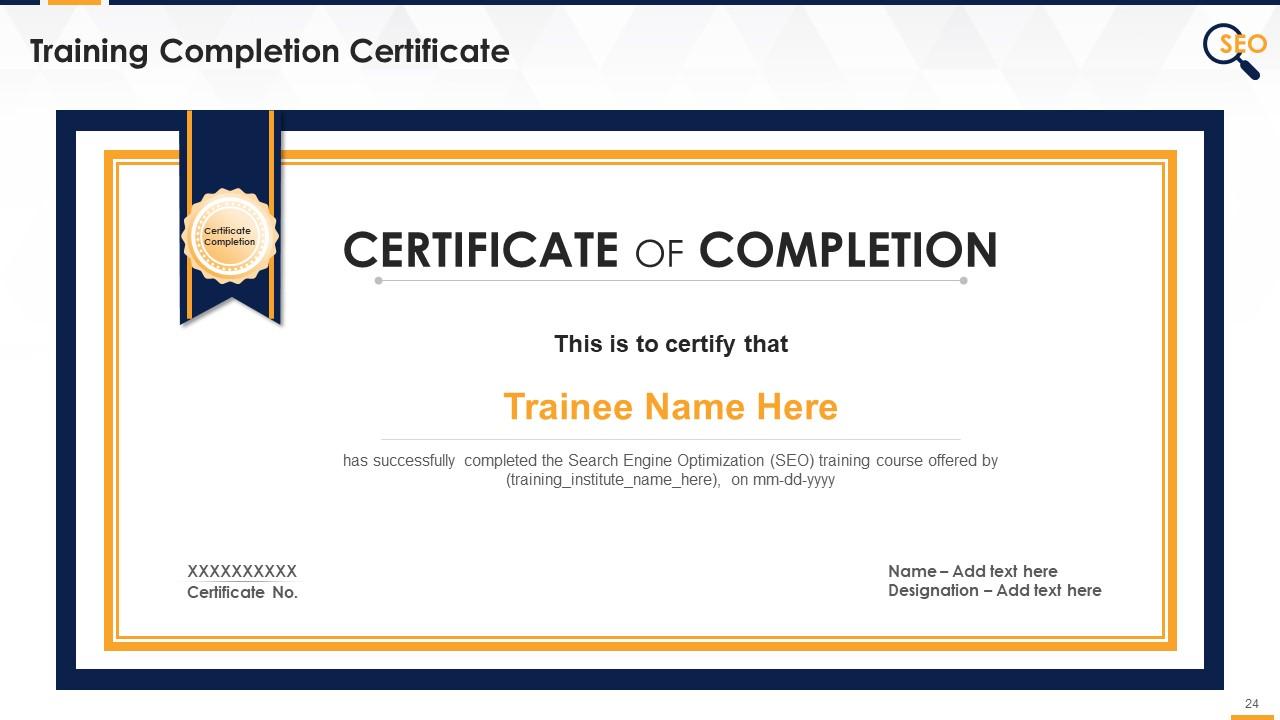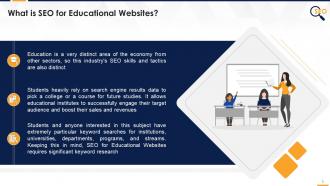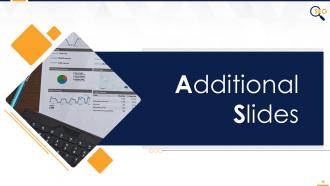SEO For Education Industry Detailed Strategy And Action Plan Edu Ppt
This set of slides includes the customized SEO approach for the education industry, such as technical and local SEO, content optimization, multilingual and mobile SEO for schools, proper navigation, optimizing the website for voice search, etc.
- Google Slides is a new FREE Presentation software from Google.
- All our content is 100% compatible with Google Slides.
- Just download our designs, and upload them to Google Slides and they will work automatically.
- Amaze your audience with SlideTeam and Google Slides.
-
Want Changes to This PPT Slide? Check out our Presentation Design Services
- WideScreen Aspect ratio is becoming a very popular format. When you download this product, the downloaded ZIP will contain this product in both standard and widescreen format.
-

- Some older products that we have may only be in standard format, but they can easily be converted to widescreen.
- To do this, please open the SlideTeam product in Powerpoint, and go to
- Design ( On the top bar) -> Page Setup -> and select "On-screen Show (16:9)” in the drop down for "Slides Sized for".
- The slide or theme will change to widescreen, and all graphics will adjust automatically. You can similarly convert our content to any other desired screen aspect ratio.
Compatible With Google Slides

Get This In WideScreen
You must be logged in to download this presentation.
PowerPoint presentation slides
Presenting SEO for Education Industry Detailed Strategy And Action Plan. This slide is well crafted and designed by our PowerPoint experts. This PPT presentation is thoroughly researched by the experts and every slide consists of an appropriate content. You can add or delete the content as per your need.
People who downloaded this PowerPoint presentation also viewed the following :
Content of this Powerpoint Presentation
Slide 3
This slide covers what SEO means for Education industry and why it is different from other industries. It also depicts that educational websites require particular keyword searches for different institutions.
Slide 4
This slide covers SEO techniques for schools, institutions, universities, departments, programs, and streams such as use of visual elements, keywords integration, domain age, fresh content & frequency, content indexing, quality, length, and mobile optimization
Instructor's Notes:
- Image Use: Using engaging visual components on educational websites, like video and pictures, will improve your search results dramatically
- Keyword Integration: Organically including relevant education field keywords in the online content enhances the pages' likelihood of being found in relevant course searches
- Page and domain authority: As more people visit the educational website and web pages, the online reputation improves, and the domain authority rises
- Freshness and Frequency of content: The quicker you generate stuff and the more fresh educational content you have, the better you will rank
- Page Architecture: Each search engine has its indexing system, and crawlers are used to assess the composition of the content. It is critical to include components such as page titles and header tags (H1s, H2s, etc) on the educational website to demonstrate to these crawlers that your content is well-structured
- Content Quality: During the optimization process, don't lose sight of the audience. Make an effort to generate high-quality content that the prospects will find entertaining and valuable
- Content Length: With an average length of 1,890 words for a top-ranked article on Google, search engines prefer lengthier content. Long-form blogs are an excellent method for schools to incorporate more lengthy content into their overall SEO plan
- Mobile-Friendliness: If the site isn't mobile-friendly, the search rating will suffer
Slide 5
This slide covers content optimization as SEO strategy for education industry. It also depicts that keywords should be included in page title, URL, H1 tag, in first paragraph of the content meta description, image files, and alt tags.
Instructor's Notes:
Keyword Research: look for keywords of all different lengths
- One to two-word phrases with a high search volume are best for headers; select some shorter, more generic keywords
- Body keywords are often two to three-word phrases with a medium search volume
- Long tail keywords — phrases with more than four words have a low search volume, are less competitive, and produce a lot of web traffic
Additional Content Optimization Tips
There are a few additional strategies to boost your school's search ranking by creating content.
- Shorter URLs are preferable to longer URLs when it comes to search algorithms
- Try to incorporate as few words as possible beyond the keyword in your URLs while still distinguishing each page
- You may do this by removing short, non-descriptive terms like "the" or "an"
Optimize multimedia content, such as video to boost the school's search ranking.
Use the following strategies to optimize video content for SEO:
- Inserting metadata such as titles, descriptions, file names, schema tags, and thumbnails
- Creating one-of-a-kind webpages for the videos
- Optimizing for YouTube by adding tags and actively attempting to increase interaction on the videos
- Inviting prospects to subscribe, directing visitors to your website, and more
- Incorporate transcripts and closed captions into your videos
Slide 6
This slide covers link building as SEO strategy for education industry. It also depicts that the more links one website gets from another, the higher will be the search engine ranking and better page & domain authority, and ranking power for linked pages.
Instructor's Notes:
Internal linking has three main functions:
- To help navigate around the website
- To display the website’s design
- To distribute page authority and ranking power
Why is it important to use links?
As website visitors consume the content on the school's webpages, you may continue to feed them links to topics that may be of interest to them. It will keep them on the website for a more extended period. The longer people remain, the better it is for the school website.
- It is also critical to include external links in the article. These links explain to search engines that the material has been thoroughly researched and deserves a spot on Google's first page
- Don't just link to any old website; instead, make sure the external links take readers to popular, authoritative websites. If you direct users to untrustworthy websites, Google may penalize the school
How will it benefit the school website?
- The use of links is another essential component of creating domain authority
- When people connect to the school's website, Google recognizes that it contains information worth linking to. The same logic applies to internal linking. When you link to other pages on the website, Google considers this as a "vote" or a sign of support for the content
- The more content gets linked to, the more votes it receives, thus ranking better in search engines. Adding internal links to the content, in other words, can boost the number of votes your page receives
Slide 7
This slide covers optimizing website performance as technical SEO strategy for education industry. Technical SEO tells what to measure, i.e. bounce rate, dwell time, page speed; and what to fix, i.e. broken redirects, dead links, and duplicate content; and what to create, i.e. sitemap & robots.txt file.
Instructor's Notes:
The school must strive to make its website as organized and glitch-free as possible. By improving technical SEO, increase search ranking, and provide prospects with a better user experience.
What to Measure
- Bounce rate: The number of users that left your website without taking any further action after reading a single page
- Dwell time: The time visitors spend on the website. As you may expect, the longer the dwell time, the better
- Page speed: It refers to how quickly the website loads. To evaluate the effectiveness of this SEO element, utilize the Page Speed Insights tools to measure. If you get a poor score, you might rework on the website design or condense the photos
What to Fix
Some technical issues can hurt the site's search ranking, so it's essential to mitigate these factors as much as possible:
- Dead links: It directs users to a nonexistent page. If something irritates the visitors, it reduces your technical SEO score
- Broken redirects: These send users to a resource that may no longer exist
- Duplicate content: refers to pages containing identical or highly similar content because it is virtually hard for search engines to decide which pages to display in search results. So often, none are shown
What to Create
- Consider establishing a sitemap and robots.txt files to make it easy for search engines to analyze the site's structure
- A sitemap is just a file that lists all of the website's URLs and is used by search engines to index the website. A robot.txt file, on the other hand, comprises the sites that you don't want to get indexed or show in search, such as particular policy pages
- By generating these files, the school can prove to search engines that its website is well-organized and, as a result, easy to browse for visitors
Slide 8
This slide covers local SEO technique as SEO strategy for education industry. Local SEO for schools include keywords optimization and NAP (name, address, and phone number) strategies.
Instructor's Notes:
Many people can call your company/school ‘HEA’, Google prefers full names as it’s easier for them to differentiate you from another unrelated business that goes by the same name.
Slide 9
This slide covers multilingual SEO technique for international student recruitment in education industry. It also depicts that translating from original website is good but search engine will give extra rewards if businesses will generate fresh, unique content for the second language page.
Slide 10
This slide covers mobile SEO technique for education industry.
Slide 11
This slide covers details on how to make mobile SEO-friendly for education industry. It also lists the methods for ensuring that your mobile site complies with search engine requirements.
Instructor's Notes:
Manually update the mobile site to improve user experience to increase mobile SEO.
Here are some methods for ensuring that your mobile site complies with search engine requirements:
- Images should be scaled for mobile users
- With only 4-8 pages, create clickable, easy-to-view navigation
- Use a hamburger menu if you need additional options
- Avoid Pop-ups
- Reduce copy above the fold
- Make your own mobile CTAs
Slide 12
This slide covers proper navigation on school website as SEO strategy for education industry. It also depicts that understanding the site's navigational system is essential for well-structured website.
Instructor's Notes:
For example: Suppose a student is looking for a bachelor's degree in chemistry. They will be given a list of institutions ranked according to their preferences. They wish to take the application process and cut-off marks once they've decided on a specific university domain. The student's search will be more straightforward if the site contains easy-to-find specific links for admission procedures, online applications, needed documents, etc.
Slide 13
This slide covers optimizing school website for voice search as SEO strategy for education industry. It also depicts that school website should include 29-words answer for school-related questions in the blog posts, which will optimize the website for voice search.
Instructor's Notes:
- A featured snippet is a brief response to a user's query that appears at the top of Google's search results. When someone does a verbal search, this is the only result that is read back to them - therefore, schools should work hard to get their site in this 'zero' position for relevant searches.
Slide 14
This slide covers monitoring SEO for school as strategy for education industry. It also depicts that education businesses must monitor their website through KPI/metrics such as loading speed, your website’s mobile-friendliness, etc.
Instructor's Notes:
- Search engine optimization isn’t a one-time thing. It’s a lifetime project. As search algorithms change with new online trends and user activities, so your website is never optimized
- With this aspect, SEO strategy for higher education must include monitoring the website’s search rankings
- Keep a check-up on your site to identify pitfalls and ensure that everything performs how you’d like it to be
- Regularly perform some of the tests mentioned above to assess your site loading speed, your website’s mobile-friendliness, and more
Additional Slide 1
This slide contains icons related to Search Engine Optimization (SEO). The slide uses the same color theme and similar design elements as the main deck.
Additional Slide 2
This slide can be edited to provide information about one's organization. The slide uses the same color theme and similar design elements as the main deck.
Additional Slide 3
This editable slide can be used to share the organization's vision, mission, and goals. The slide uses the same color theme and similar design elements as the main deck.
Additional Slide 4
This slide can be edited to provide information about the organization's core team. The slide uses the same color theme and similar design elements as the main deck.
Additional Slide 5
This slide can be used to present multiple discussion ideas to the stakeholders concerned.
Additional Slide 6
This slide contains an editable 30-60-90-day plan to suit the presenter's needs.
Additional Slide 7
This slide contains a timeline to showcase multiple milestones of the organization.
Additional Slide 8
This slide contains a roadmap template for effective strategic planning. The slide uses the same color theme and similar design elements as the main deck.
Additional Slide 9
This fully editable training certificate template can be presented to attendees post the successful completion of training.
SEO For Education Industry Detailed Strategy And Action Plan Edu Ppt with all 29 slides:
Use our SEO For Education Industry Detailed Strategy And Action Plan Edu Ppt to effectively help you save your valuable time. They are readymade to fit into any presentation structure.
-
Appreciate the research and its presentable format.
-
Informative presentations that are easily editable.



